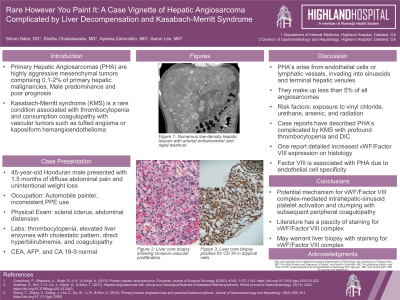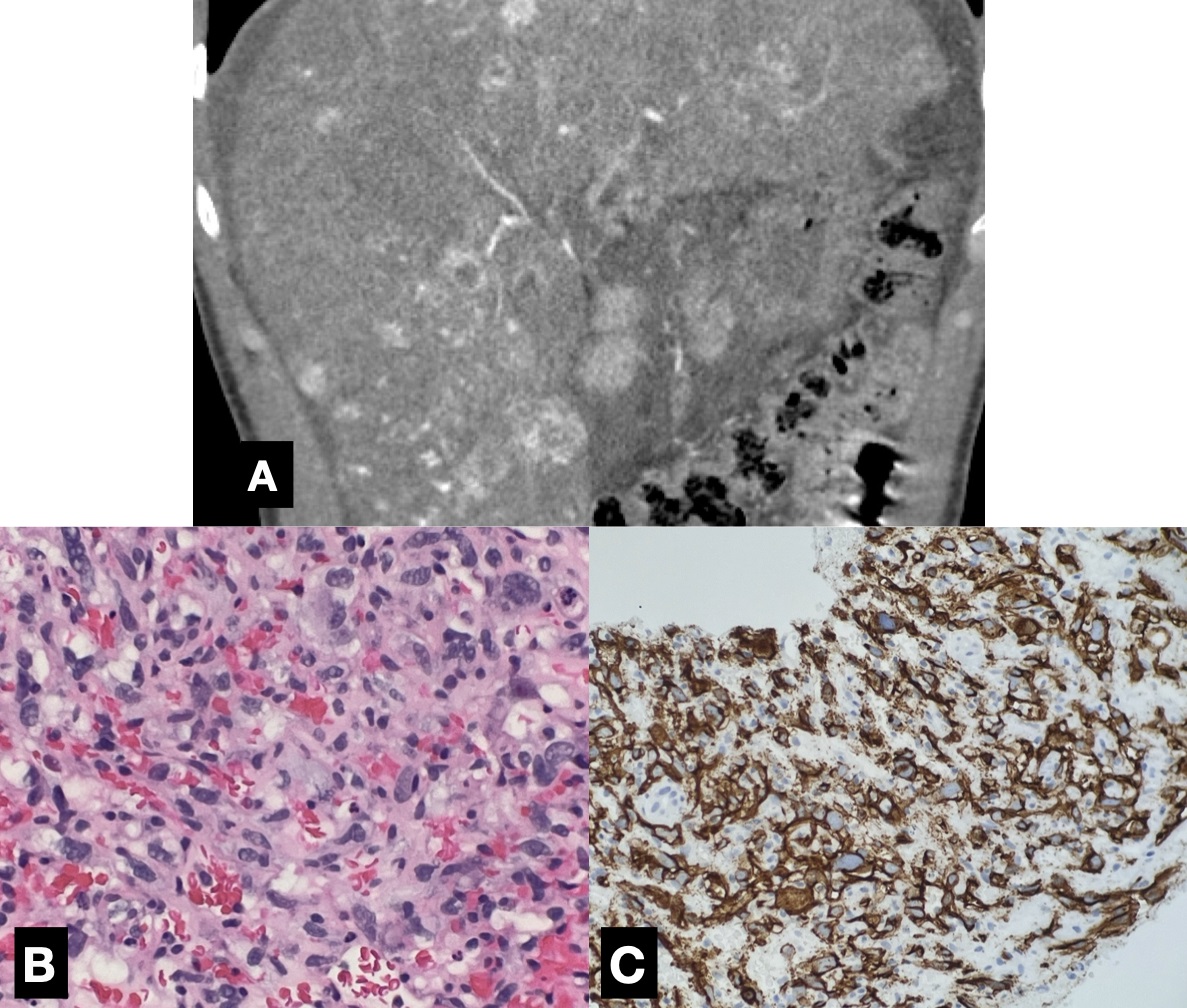Tuesday Poster Session
Category: Liver
P4737 - Rare However You Paint It: Hepatic Angiosarcoma Complicated by Liver Decompensation and Kasabach–Merritt Syndrome
Tuesday, October 29, 2024
10:30 AM - 4:00 PM ET
Location: Exhibit Hall E

- SS
Simon Sabir, DO
Alameda Health System
Oakland, CA
Presenting Author(s)
Simon Sabir, DO, Sindhu Chadalawada, MD, Ayesha Zahiruddin, MD, Aaron Lee, MD
Alameda Health System, Oakland, CA
Introduction: Primary Hepatic Angiosarcomas (PHA) are highly aggressive mesenchymal tumors comprising 0.1-2% of primary hepatic malignancies with a male predominance and poor prognosis. Kasabach-Merritt syndrome (KMS) is a rare condition associated with thrombocytopenia and consumption coagulopathy with vascular tumors such as tufted angioma or kaposiform hemangioendothelioma. We present a case of PHA complicated by hepatic decompensation and DIC with features of KMS.
Case Description/Methods: A 45-year-old Honduran male presented with 1.5 months of abdominal pain and weight loss. Occupational history noted automobile painting and inconsistent PPE use. Physical exam showed scleral icterus and abdominal distention. Workup revealed thrombocytopenia, elevated liver enzymes with a cholestatic pattern, direct hyperbilirubinemia, and coagulopathy. Computed tomography (CT) with contrast demonstrated innumerable low-density liver lesions with a thick rind of enhancement, lobulated hepatomegaly, and ascites. CT Liver triphase showed arterial phase enhancement of the lesions with rapid washout. CEA, AFP, and CA 19-9 tumor markers were normal. Liver biopsy revealed invasive vascular proliferation with nuclear hyperchromasia and scattered cells with nuclear pleomorphism. Immunohistochemistry was positive for CD34, P53 overexpression, and increased Ki-67 consistent with PHA. Given the degree of liver dysfunction and metastatic disease, chemotherapy and liver transplantation were not pursued. Hospital course was complicated by variceal bleeding requiring banding, acute tubular necrosis necessitating dialysis, and DIC. The patient expired from hemorrhagic shock.
Discussion: PHA’s arise from endothelial cells or lymphatic vessels, invading into sinusoids and terminal hepatic venules. They make up less than 5% of all angiosarcomas. Risk factors include exposure to vinyl chloride, urethane, arsenic, and radiation. Case reports have described PHA’s complicated by KMS with profound thrombocytopenia and DIC. One report detailed increased vWF/Factor VIII expression on histology, providing a potential mechanism for vWF/Factor VIII complex-mediated intrahepatic-sinusoid platelet activation and clumping with subsequent peripheral coagulopathy. This case demonstrates toxin-related PHA complicated by KMS. Literature has a paucity of staining for vWF/Factor VIII complex, though Factor VIII is associated with PHA due to endothelial cell specificity. As such, liver biopsy with staining for vWF/Factor VIII complex may be warranted.

Disclosures:
Simon Sabir, DO, Sindhu Chadalawada, MD, Ayesha Zahiruddin, MD, Aaron Lee, MD. P4737 - Rare However You Paint It: Hepatic Angiosarcoma Complicated by Liver Decompensation and Kasabach–Merritt Syndrome, ACG 2024 Annual Scientific Meeting Abstracts. Philadelphia, PA: American College of Gastroenterology.
Alameda Health System, Oakland, CA
Introduction: Primary Hepatic Angiosarcomas (PHA) are highly aggressive mesenchymal tumors comprising 0.1-2% of primary hepatic malignancies with a male predominance and poor prognosis. Kasabach-Merritt syndrome (KMS) is a rare condition associated with thrombocytopenia and consumption coagulopathy with vascular tumors such as tufted angioma or kaposiform hemangioendothelioma. We present a case of PHA complicated by hepatic decompensation and DIC with features of KMS.
Case Description/Methods: A 45-year-old Honduran male presented with 1.5 months of abdominal pain and weight loss. Occupational history noted automobile painting and inconsistent PPE use. Physical exam showed scleral icterus and abdominal distention. Workup revealed thrombocytopenia, elevated liver enzymes with a cholestatic pattern, direct hyperbilirubinemia, and coagulopathy. Computed tomography (CT) with contrast demonstrated innumerable low-density liver lesions with a thick rind of enhancement, lobulated hepatomegaly, and ascites. CT Liver triphase showed arterial phase enhancement of the lesions with rapid washout. CEA, AFP, and CA 19-9 tumor markers were normal. Liver biopsy revealed invasive vascular proliferation with nuclear hyperchromasia and scattered cells with nuclear pleomorphism. Immunohistochemistry was positive for CD34, P53 overexpression, and increased Ki-67 consistent with PHA. Given the degree of liver dysfunction and metastatic disease, chemotherapy and liver transplantation were not pursued. Hospital course was complicated by variceal bleeding requiring banding, acute tubular necrosis necessitating dialysis, and DIC. The patient expired from hemorrhagic shock.
Discussion: PHA’s arise from endothelial cells or lymphatic vessels, invading into sinusoids and terminal hepatic venules. They make up less than 5% of all angiosarcomas. Risk factors include exposure to vinyl chloride, urethane, arsenic, and radiation. Case reports have described PHA’s complicated by KMS with profound thrombocytopenia and DIC. One report detailed increased vWF/Factor VIII expression on histology, providing a potential mechanism for vWF/Factor VIII complex-mediated intrahepatic-sinusoid platelet activation and clumping with subsequent peripheral coagulopathy. This case demonstrates toxin-related PHA complicated by KMS. Literature has a paucity of staining for vWF/Factor VIII complex, though Factor VIII is associated with PHA due to endothelial cell specificity. As such, liver biopsy with staining for vWF/Factor VIII complex may be warranted.

Figure: A. Numerous low-density hepatic lesions with arterial enhancement and rapid washout
B. Liver core biopsy showing invasive vascular proliferation
C. Liver core biopsy positive for CD 34 in atypical cells
B. Liver core biopsy showing invasive vascular proliferation
C. Liver core biopsy positive for CD 34 in atypical cells
Disclosures:
Simon Sabir indicated no relevant financial relationships.
Sindhu Chadalawada indicated no relevant financial relationships.
Ayesha Zahiruddin indicated no relevant financial relationships.
Aaron Lee indicated no relevant financial relationships.
Simon Sabir, DO, Sindhu Chadalawada, MD, Ayesha Zahiruddin, MD, Aaron Lee, MD. P4737 - Rare However You Paint It: Hepatic Angiosarcoma Complicated by Liver Decompensation and Kasabach–Merritt Syndrome, ACG 2024 Annual Scientific Meeting Abstracts. Philadelphia, PA: American College of Gastroenterology.
